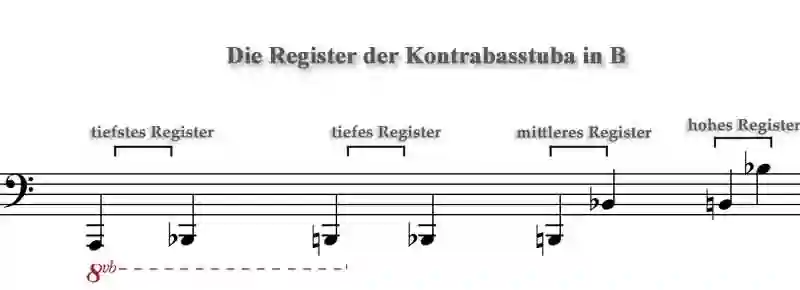Sound character of the Contrabass tuba » Philipp Dangas
Register table of the contrabass tuba
Due to its majestic, abysmal and rumbling sound, the contrabass tuba is mainly only suitable for playing slow, sustained tone sequences in the lowest range of the orchestra scale, i.e. in the contra octave range. The tones of the lowest register can only be produced by very powerful wind instruments, at most mezzoforte [mf] - forte [f]. The sound effect is only a deep rumble, the exact pitch of which can hardly be determined. As with the double basses, the double bass trombone and the contrabassoon, these tones are only used with doubling in the upper octave.
The lower register contains the main sphere of action of the contrabass tuba, whose primary task is to play the lowest registers of the tuba's sound range. The middle register follows the low register homogeneously. The sound of the middle register is no longer as strong as the sound of the low register, but it is still quite intense. The sound of the high register can be described as thick-sounding, but due to the wide cone it is very dull and completely lackluster.
As part of the „symphonic world music“
The contrabass tuba is responsible for the execution of the funtamental bass in the orchestra and should not be regarded as a means of making noise. In addition, the contrabass tuba is another instrument for realizing the desired sound character and an important partner of the contra-instruments in the orchestra, i.e. the double basses and the contrabassoon.
Download size: 133 kilobytes
Table summary of the sound character of the contrabass tuba
The following table shows the registers and timbres of the double bass tuba wind instrument briefly described. The high register becomes the middle register and the low register and the deepest register described.

The register table of a contrabass tuba in a large representation
- high register
- Strong and thick-sounding, but very dull and completely lackluster
- middle register
- Homogeneous connection to the lower register, but not as strong but intensive
- low register
- Main area of effect, lowest notes of the register sound worse, overall strong and blaring
- lowest register
- Deep rumble, the exact pitch can hardly be determined.
Internal search function
| Name | Value | Delete |
|---|